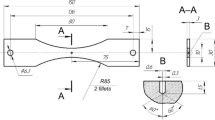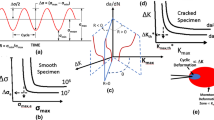Summary
The paper is designed to develop the two-parameter failure criterion for describing the growth of fatigue cracks under conditions of high-temperature fatigue. The criterion can be used with laboratory tests on specimens to construct kinetic diagrams for fatigue failure such as would be given if the requirements of linear failure mechanics were met. The initial data are the v-ΔKeff fatigue failure diagrams, which are effective ones incorporating crack closure, so one can derive v-ΔKv theoretical diagrams as conservative characteristics for a material for crack growth under conditions of planar strain.
The two-parameter criterion enables one to incorporate the effects of frequency and cycle asymmetry at high ΔK, where there are changes in crack growth rate due to changes in the rate of plastic strain at the crack vertex. At low ΔK, the effects of loading frequency are additionally determined by the crack closure, the blunting, and the physicochemical action of the medium, which restricts the scope for using the two-parameter criterion to construct fatigue-failure kinetic diagrams invariant with respect to frequency.
Similar content being viewed by others
Literature cited
K. Sadananda and P. Shahinian, “Application of J-integral parameter to high temperature fatigue crack growth in cold worked type 316 stainless steel,” Int. J. Fracture,15, No. 2, R81-R84 (1979).
S. Taira, R. Ohtani, and T. Komatsu, “Application of K-integral to high-temperature crack propagation. Part 2. Fatigue crack propagation,” Trans. ASME, J. Eng. Mater. Technol.,101, No. 2, 162–167 (1979).
R. Koterazawa and T. Mari, “Fracture mechanics and fractography of creep and fatigue crack propagation at elevated temperatures,” Proc. 1st Mech. Eng. Int. Conf. Engineering Aspects of Creep, Vol. 1, Sheffield (1980), pp. 219–225.
J. D. Landes and J. A. Begley, “A fracture mechanics approach to creep crack growth,” Mechanics of Crack Growth, Philadelphia (1976), pp. 128–148 (Amer. Soc. Test. Mater., ASTM STP 590).
P. Shahinian, “Fatigue crack growth characteristics of high-temperature alloys,” Metals Technol.,5, No. 11, 372–380 (1978).
L. A. James, “The effect of temperature upon the fatigue-crack growth behavior of two nickel-base alloys,” Trans. ASME, J. Eng. Mater. Technol.,H95, No. 4, 254–256 (1973).
Xie Jizhou and Liu Shaolun, “An investigation of high temperature LCF crack growth rates for directionally solidifed alloy K5,” Fatigue 84: Proc. 2nd Int. Conf. Fatigue and Fatigue Thresholds, Vol. 3, Birmingham (1984), pp. 1389–1396.
O. M. Romaniv, G. M. Nikiforchin, O. Z. Student, and I. D. Skripnik, “A two-parameter failure criterion for fatigue crack growth,” Fiz.-Khim. Mekh. Mater., No. 1, 46–54 (1990).
I. D. Skrypnik, Estimating the Severity of the Strain State Near a Crack Vertex [in Russian], L'vov (1990), Dep. VINITI No. 2119-V90, 20 April (1990).
G. M. Nikiforchin, O. Z. Student, I. D. Skripnik, et al., “High-temperature cracking resistance in cast steel from reforming oven tubes,” Fiz.-Khim. Mekh. Mater., No. 2, 68–74 (1990).
O. N. Romaniv, G. N. Nikiforchin, B. N. Andrusiv, and L. Yu. Kozak, Inventor's Certificate No. 1147948, IPC4 G01N3/00. A Method of Preparing a Specimen Containing a Crack [in Russian], Publ. 30 March (1985), Byul. No. 12.
G. N. Nikiforchin, B. N. Andrusiv, A. V. Vol'demarov, and M. A. Kutsyn, “Estimating the effects from fatigue crack closure,” Fiz.-Khim. Mekh. Mater., No. 5, 100–103 (1982).
S. J. Zhu, J. Zha., F. G. Wang, and Z. B. Cao, “Effect of carbides and cavities on creep crack growth in HK40 steel,” Advances in Fracture Research: Proc. 7th Int. Conf. Fract., Vol. 2, Pergamon Press, Oxford (1989), pp. 1699–1706.
O. N. Romaniv and G. N. Nikiforchin, The Mechanics of Corrosion Failure in Constructional Alloys [in Russian], Metallurgiya, Moscow (1986).
O. N. Romaniv, G. N. Nikiforchin, and B. N. Andrusiv, “Crack-closure effects and cyclic cracking resistance evaluation for constructional alloys,” Fiz.-Khim. Mekh. Mater., No. 3, 47–61 (1983).
O. M. Romaniv, G. M. Nikiforchyn, and A. N. Tkach, “The influence of microstructure and environment on the near-threshold crack propagation in iron-based alloys,” Proc. 6th Inst. Symp. High Purity Materials in Science and Technology, Vol. 3, Dresden (1988), pp. 179–195.
Yu. N. Lenets, Forecasting Cyclic Cracking Resistance and Optimizing Structure in Constructional Steels on the Basis of a Crack Closure Concept: Ph. D. Thesis [in Russian], Kiev (1987), 18 pp.
O. N. Romaniv, S. Ya. Yarema, G. N. Nikiforchin, et al., Failure Mechanics and Material Strength: Textbook in 4 volumes, General Editor V. V. Panasyuk. Vol. 4, Fatigue and Cyclic Cracking Resistance in Constructional Materials [in Russian], Naukova Dumka, Kiev (1990).
G. N. Nikiforchin, B. N. Andrusiv, and L. Yu. Kozak, “Effects of specimen geometry on the threshold growth of fatigue cracks in plastic steel,” Fiz.-Khim. Mekh. Mater., No. 4, 123–124 (1983).
G. N. Nikiforchin, A. A. Popov, B. N. Andrusiv, and Yu. V. Zima, “Scale-factor effects on cyclic cracking resistance in plastic steels in the low-amplitude loading range,” ibid., No. 4, 57–64 (1985).
Author information
Authors and Affiliations
Additional information
Translated from Fiziko-khimicheskaya Mekhanika Materialov., Vol. 26, No. 5, pp. 9–19, September–October, 1990.
Rights and permissions
About this article
Cite this article
Romaniv, O.M., Nikiforchin, G.M., Student, O.Z. et al. A two-parameter damage criterion and high-temperature fatigue crack growth in a corrosion-resistant steel. Mater Sci 26, 497–505 (1991). https://doi.org/10.1007/BF00732700
Received:
Issue Date:
DOI: https://doi.org/10.1007/BF00732700




